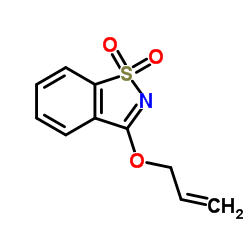3-(Allyloxy)-1,2-benzothiazole 1,1-dioxide

3-(Allyloxy)-1,2-benzothiazole 1,1-dioxide structure
|
Common Name | 3-(Allyloxy)-1,2-benzothiazole 1,1-dioxide | ||
|---|---|---|---|---|
| CAS Number | 27605-76-1 | Molecular Weight | 223.248 | |
| Density | 1.3±0.1 g/cm3 | Boiling Point | 369.0±35.0 °C at 760 mmHg | |
| Molecular Formula | C10H9NO3S | Melting Point | 139 °C | |
| MSDS | USA | Flash Point | 177.0±25.9 °C | |
|
Characterization of PBZ1, a probenazole-inducible gene, in suspension-cultured rice cells.
Biosci. Biotechnol. Biochem. 65(1) , 205-8, (2001) Probenazole (PBZ) induces non-race specific resistance in rice plants against rice blast fungus and PBZ1 was identified as a PBZ-inducible gene from rice. The induction of PBZ1 expression in suspension-cultured rice cells was investigated. Northern blot analy... |
|
|
Different responses of two genes associated with disease resistance loci in maize (Zea mays L.) to 3-allyloxy-1,2-benzothiazole 1,1-dioxide.
Curr. Issues Mol. Biol. 11 Suppl 1 , i85-94, (2009) Probenazole (3-allyloxy-1,2-benzothiazole 1,1-dioxide, PBZ) is a bactericide and fungicide that acts by inducing plant defense systems. It has been shown to induce the expression of NBS-LRR genes like RPR1 (rice probenazole-response gene) in rice (Oryza sativ... |
|
|
Proteome analysis of probenazole-effect in rice-bacterial blight interactions.
Protein Pept. Lett. 16(9) , 1041-52, (2009) To study the effect of probenazole on the induced systemic resistance mechanism of rice-bacterial interaction, a proteomic approach was applied. Oryza sativa cv. Java 14 seedlings were treated with probenazole, followed by inoculation with compatible (Xo7435)... |
|
|
Occupational contact dermatitis caused by probenazole in agricultural chemical factories.
Contact Dermatitis 61(6) , 350-1, (2009)
|
|
|
Semisynthesis and antifeedant activity of new derivatives of a dihydro-β-agarofuran from Parnassia wightiana.
Int. J. Mol. Sci. 14 , 19484-93, (2013) Five new derivatives (2-6) were semi-synthesized using compound 1, a dihydro-β-agarofuran sesquiterpene with C-2 ketone obtained from Parnassia wightiana, as the starting material by acylation, oxidation, reduction, esterification, and amination, respectively... |
|
|
A novel rice PR10 protein, RSOsPR10, specifically induced in roots by biotic and abiotic stresses, possibly via the jasmonic acid signaling pathway.
Plant Cell Physiol. 45(5) , 550-9, (2004) Plant roots have important roles not only in absorption of water and nutrients, but also in stress tolerance such as desiccation, salt, and low temperature. We have investigated stress-response proteins from rice roots using 2-dimensional polyacrylamide-gel e... |
|
|
Contribution of salicylic acid glucosyltransferase, OsSGT1, to chemically induced disease resistance in rice plants.
Plant J. 57(3) , 463-72, (2009) Systemic acquired resistance (SAR), a natural disease response in plants, can be induced chemically. Salicylic acid (SA) acts as a key endogenous signaling molecule that mediates SAR in dicotyledonous plants. However, the role of SA in monocotyledonous plants... |
|
|
Characterization of RCI-1, a chloroplastic rice lipoxygenase whose synthesis is induced by chemical plant resistance activators.
Eur. J. Biochem. 267(19) , 5935-42, (2000) A full-length lipoxygenase cDNA (RCI-1) has been cloned from rice (Oryza sativa) whose corresponding transcripts accumulate in response to treatment of the plants with chemical inducers of acquired resistance such as benzo(1,2,3)thiadiazole-7-carbothioic acid... |
|
|
Rice WRKY45 plays important roles in fungal and bacterial disease resistance.
Mol. Plant Pathol. 13(1) , 83-94, (2012) Plant 'activators', such as benzothiadiazole (BTH), protect plants from various diseases by priming the plant salicylic acid (SA) signalling pathway. We have reported previously that a transcription factor identified in rice, WRKY45 (OsWRKY45), plays a pivota... |
|
|
Probenazole induces systemic acquired resistance in Arabidopsis with a novel type of action.
Plant J. 25(2) , 149-57, (2001) Probenazole (PBZ; 3-allyloxy-1,2-benzisothiazole-1,1-dioxide), which is the active ingredient in Oryzemate, has been used widely in Asia to protect rice plants against the rice blast fungus Magnaporthe grisea. To study PBZ's mode of action, we analyzed its ab... |